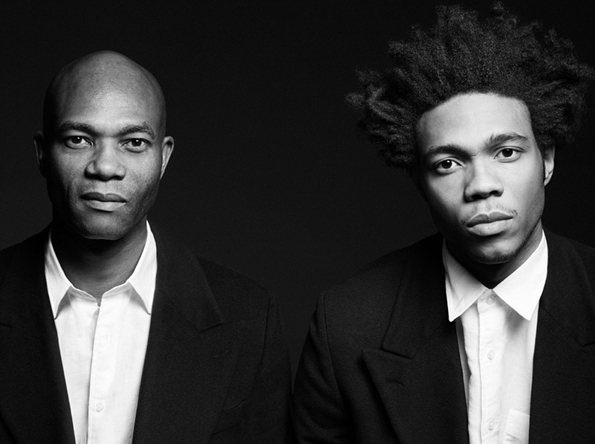Cutting a dash in Dalston

Joe Casely-Hayford with his son, Charlie Photo: Ben Weller
BONO had called Joe Casely-Hayford at three in the morning. He needed a bespoke suit to wear to David Bowie’s wedding. And he needed it in three days. Casely-Hayford delivered.
This may say plenty about the tradition of rock star demands, but it also points to Casely-Hayford’s skill as a fashion designer and craftsman.
“Everything then was done on a knife-edge,” says the British designer and long-term Hackney resident. “I had to make platform shoes for him in about ten minutes and then watch him on stage just hoping he didn’t fall over. But it was fun and it was a challenge, trying to shape the way the band looked…”
That was back in the 1980s, when Casely-Hayford was establishing his eponymous men’s label comprising sharp modern and very English classics with an emphasis on clever deconstruction, draping and detail. He toured with U2 for two years and style consulted for the likes of The Clash and Oasis.
Now he is on more solid ground, with recent work including exhibition design for the Barbican, the creative directorship of Savile Row tailors Gieves & Hawkes, costume design for ballet, and uniform design for Terence Conran.
Today he is busy launching a new made-to-measure tailoring service for a hardcore fan base of creative types, as well as feeding a cultish following in Japan. He is also working with a new collaborator, his 23-year-old son, Charlie. Together they have effectively re-launched as ‘Casely-Hayford’ to pursue what they call ‘performance tailoring’: all the dapperness of sartorial tradition with the comfort and functionality of sportswear.
Charlie is following in dad’s footsteps. Like his father, Charlie attended Central St Martins and then studied art history. Yet a touch of rebellion runs in the family. After all, Joe rejected a long family tradition of heavyweight law and politics (he is the grandson and namesake of the Ghanaian statesman and exponent of Pan-Africanism) to pursue fashion himself.
“I basically grew up in the studio so it was hard to escape fashion,” says Charlie. “My father actually tried quite hard to push me away from it because it’s a tough industry and I don’t think he wanted me to go through the trials that he had to get to where he is.
“And I also had concerns. It’s fashionable now for the children of ‘famous’ people to come into the public eye themselves and I don’t want to be considered part of that. You have to be sceptical of them until they’ve proven they have some talent. I’m very keen to prove myself.”
Yet it seems apt that Joe has found a partner in the family, as his wife Maria has long run the business side. Perhaps keeping it in the family is one way to tackle the notorious vicissitudes of the industry, those that almost persuaded Joe himself to give it a miss.
After graduating he worked as a buyer for a number of companies here and in Italy. Disillusionment resulted – “all I found myself being asked to do was buy up other designers’ collections so they could then be taken apart and copied,” he says – so he opened an antiques shop.
It was only when a client later uncovered a warehouse full of old WW2 tent fabric and suggested Casely-Hayford make something out of it – with the jackets, shirts and skirts that resulted immediately selling to London and New York’s more hip stores – that the late Joe Casely-Hayford line was born.
Then, as now, the Casely-Hayford aesthetic is more in keeping with the artisan-makers of East London than the flash brand giants of the West. For Joe it is the cultural mix here that he finds inspiring, while for Charlie it is a place of great energy.
“I remember going out with friends who lived in Chelsea and getting the 38 home and thinking they all lived in a bubble and didn’t know what the real world was,” he says.
“Things have changed. When I was 14, I knew west London people who’d never heard of Hackney. I had to tell them it was beyond Tottenham Court Road because that’s as far east as they’d ever been. Now they’re all here.”
One generation looks forward, another back, and, together they aim to do something timeless together.
“I remember those early days of building the business were great ones for design,” Joe recalls.
“The emphasis on global brands today has diluted talent and made the fashion aesthetic more about pop culture and emulating pop stars. But the demands to grow mean those ‘luxury’ brands have had to sell to the masses, and the result is they’ve oversold themselves. People are starting to question their interest in such huge companies, and starting to realise again that small can be good.”
As a new enterprise Casely-Hayford may now be small. But with Hackney’s heritage in fostering artistic talent and the originality of this father-son team, changing that will only be a question of a season or two.
